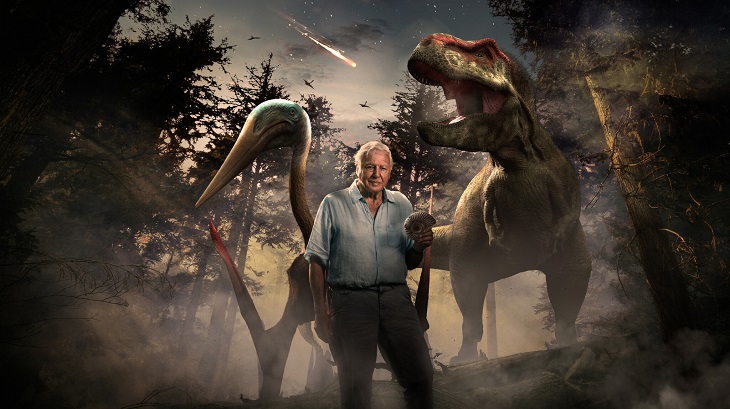
TORONTO — Blue Ant Media announced today BBC Earth will premiere a new two-part special, Dinosaur Apocalypse, hosted by well-known naturalist and documentary maker Sir David Attenborough (above), on Thursday, June 9 at 9 p.m. ET/PT.
This one-night, two-hour special explores “how a wealth of newly uncovered fossils may provide a never-before-seen glimpse of events on the day an asteroid struck Earth, ending the age of the dinosaurs 66 million years ago,” reads a press release.
Although there is strong evidence of the asteroid’s impact, “no fossils of a dinosaur killed in the event itself have ever been found. Now, at a dig site hidden in the Badlands of North Dakota, scientists have uncovered a wealth of fossilized creatures that might be connected to the fateful day that ended the Cretaceous Period,” the release explains.
“In Dinosaur Apocalypse, Sir David Attenborough follows clues from this prehistoric graveyard, where a team of paleontologists uncover evidence they believe could help shed light on some dinosaurs’ final moments on Earth.”
In the first one-hour episode, Dinosaur Apocalypse: The New Evidence, “viewers are introduced to the excavation of several groundbreaking finds in a corner of the Hell Creek Formation”, including “an incredibly rare fossilized egg with the embryo of a pterosaur — a flying reptile — still inside, a fossilized burrow possibly dug by an early mammal such as a pediomyid, and a beautifully preserved piece of Triceratops skin.”
The team investigating the finds, led by paleontologist Robert DePalma, “begins to paint a vivid picture of what life was like here during this period, showing how the creatures would have looked, lived, and interacted.”
Episode two, Dinosaur Apocalypse: The Last Day (airing at 10 p.m. ET/PT on June 9), “begins with DePalma and his team unearthing what appear to be ejecta spherules — tiny beads of molten and vaporized rock created by an asteroid impact — some of which have been preserved in amber. Closer study of one of these spherules reveals a speck of rock that is reportedly a chemical match to the asteroid itself,” the release says.
“Nearby, the team uncovers what could be the leg of a small, herbivorous dinosaur called a Thescelosaurus — a creature that DePalma thinks may have experienced firsthand the deadly events triggered by the cataclysmic impact. If confirmed by further research, this would be the first time the fossil of a dinosaur that appears to have been killed by effects of the asteroid impact has been uncovered.”
Drawing on detailed examinations of the fossils, DePalma’s team tries to piece together the chain of events that devastated this region. The episode “culminates with a blow-by-blow CGI visualization of the destruction — earthquakes, fire, and a devastating surge wave that entombs and preserves the creatures here — only to be dug up 66 million years later by scientists.”
Dinosaur Apocalypse shows Attenborough examining some of the fossil finds with experts and following the dig team “as they carry out cutting-edge visualization and scanning techniques to reveal fossilized secrets invisible to the naked eye,” the release says.
The special uses CGI storytelling, based on the evidence unearthed by DePalma and his team, “to transport Attenborough back in time to the Late Cretaceous Period and bring the creatures that lived here to life.”
Filmed over the course of three years, Dinosaur Apocalypse is a BBC Studios Science Unit production with NOVA and GBH for BBC One and iPlayer, and PBS, co-produced with France Télévisions. The series is part of a co-production deal between PBS and BBC Studios.
Image provided by Blue Ant Media.



